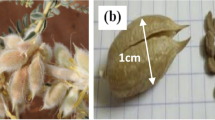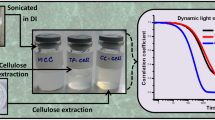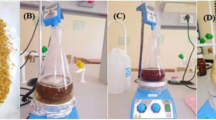Abstract
Several modified celluloses have shown profound benefits in several areas of application. However, there is a lack of little information on the safety profile of most modified celluloses such as cellulose ester. In response to this, cellulose (WMC) was isolated from the watermelon exocarp (WM) of the unexploited watermelon fruit. WMC was converted to cellulose ester (WMS) by simple modification with sebacic acid. WM, WMC and WMS were characterized using X-ray diffraction (XRD), particle size distribution (PSD), Fourier-transform infrared spectroscopy (FTIR), thermogravimetric (TG) analysis, zeta potential and scanning electron microscopy (SEM). The diffractogram revealed that WMS might be classified as cellulose I with a crystallinity of 78.21%. Its surface appears homogeneous, lumpish, having white gel appearance with agglomerates. The impact of WMS on hepato-renal functional indices and hepatic oxidative stress parameters was examined in male Wistar rats for 14 days. At the end of the 14-day exposure, WMS reduced malondialdehyde and nitric oxide concentrations, while glutathione peroxidase activity was significantly elevated, especially at the dose of 200 mg/kg. Also, microscopic analysis of the hepato-renal organs revealed histological abnormalities. Quantum chemical parameters using the density functional theory (DFT) approach were applied to gain theoretical insight into the renotoxic effect exhibited by WMS in molecular terms. The lowest unoccupied molecular orbital (LUMO) and the highest occupied molecular orbital (HOMO) are distributed over the molecules of WMS, suggesting that its renotoxic effect may have occurred via donor–acceptor interactions. Taken together, our data suggest an increase in the susceptibility of kidney to toxicity after subacute exposure to WMS.












Similar content being viewed by others
References
Heinze T, Liebert T (2012) In: Matyjaszewski K, Möller M (eds) polymer science: a comprehensive reference. Elsevier, Amsterdam, pp 83–152
Jedvert K, Heinze T (2017) Cellulose modification and shaping—a review. J Polym Eng 37:845–860. https://doi.org/10.1515/polyeng-2016-0272
Akter F, Rifat SM, Rahman SMM, Muslim T, Rahman MA (2015) Isolation of cellulosic material from drumstick pulp and outer shell of watermelon and preparation of their acetate and carboxymethyl derivatives. Int J Adv Pharm Biol Chem 4:218–222
Einfeldt L, Günther W, Klemm D, Heublein B (2005) Peracetylated cellulose: end group modification and structural analysis by means of 1H-NMR spectroscopy. Cellulose 12:15–24. https://doi.org/10.1023/B:CELL.0000049355.93592.44
Ma T, Zhao QQ, Ji KH, Zeng B, Li GQ (2014) Homogeneous and porous modified bacterial cellulose achieved by in situ modification with low amounts of carboxymethyl cellulose. Cellulose 21:2637–2646. https://doi.org/10.1007/s10570-014-0316-1
Hossain I, Mostofa S, Muslima U, Akter F, Tania SA, Saha A, Debnath S, Muslim T, Rahman MA (2015) Isolation of cellulosic material from Agro-wastes and their derivatization. Dhaka Univ J Sci 63:43–46. https://doi.org/10.3329/dujs.v63il.21767
Candido RG, Godoy GG, Goncalves AR (2017) Characterization and application of cellulose acetate synthesized from sugarcane bagasse. Carbohydr Polym 167:280–289. https://doi.org/10.1016/j.carbpol.2017.03.057
Wu C, Zhang X, Wang X, Gao Q, Li X (2019) Surface modification of cellulose nanocrystal using succinic anhydride and its effects on poly(butylene succinate) based composites. Cellulose 26:3167–3181. https://doi.org/10.1007/s10570-019-02292-5
Cichosz S, Masek A, Wolski K, Zaborsk M (2019) Universal approach of cellulose fibres chemical modification result analysis via commonly used techniques. Polym Bull 76:2147–2162. https://doi.org/10.1007/s00289-018-2487-7
Reis DT, Ribeiro HIS, Pereira DH (2019) DFT study of the application of polymers cellulose and cellulose acetate for adsorption of metal ions (Cd2+, Cu2+ and Cr3+) potentially toxic. Polym Bull 2019:1–14. https://doi.org/10.1007/s00289-019-02926-5
Hamdaoui LE, Moussaouiti ME, Gmouh S (2015) Preparation and characterization of cellulose p-phenylbenzoate by two-step synthesis from microcrystalline and kraft cellulose. Polym Bull 72:3031–3042. https://doi.org/10.1007/s00289-015-1451-z
Yin X, Yu C, Zhang X, Yang J, Lin Q, Wang J, Zhu Q (2011) Comparison of succinylation methods for bacterial cellulose and adsorption capacities of bacterial cellulose derivatives for Cu2+ ion. Polym Bull 67:401–412. https://doi.org/10.1007/s00289-010-0388-5
Bodin A, Concaro S, Brittberg M, Gatenholm P (2007) Bacterial cellulose as a potential meniscus implant. J Tissue Eng Regen Med 1:406–408. https://doi.org/10.1002/term.51
Svensson A, Nicklasson E, Harrah T, Panilaitis B, Kaplan DL, Brittberg M, Gatenholm P (2005) Bacterial cellulose as a potential scaffold for tissue engineering of cartilage. Biomaterials 26:419–431. https://doi.org/10.1016/j.biomaterials.2004.02.049
Fischer S, Thümmler K, Volkert B, Hettrich K, Schmidt I, Fischer K (2008) Properties and applications of cellulose acetate. Macromol Symp 262:89–96. https://doi.org/10.1002/masy.200850210
Edgar KJ (2007) Cellulose esters in drug delivery. Cellulose 14:49–64. https://doi.org/10.1007/s10570-006-9087-7
Beinborn NA, Williams RO (2013) Polymeric biomaterials in pulmonary drug delivery. Polymeric biomaterials, medicinal and pharmaceutical applications, vol 2. CRC Press, Boca Raton
Adewuyi A, Oderinde RA, Rao BVSK, Prasad RBN (2012) Chemical composition and molecular speciation of the triacylglycerol of the oils of Lonchocarpus sericeus and Lonchocarpus cyanescens. Nat Prod Res 26:1954–1956. https://doi.org/10.1080/14786419.2011.643311
Adewuyi A, Pereira FV (2017) Cellulose nanocrystals from underutilized Polythia longifolia seed. Periodico Tche Quim 14:10–18
Zhang M, Zhang CJ, Shrestha S (2005) Study on the preparation technology of superfine ground powder of Agrocybe chaxingu Huang. J Food Eng 67:333–337. https://doi.org/10.1016/j.jfoodeng.2004.04.036
Lu H, Gui Y, Zheng L, Liu X (2013) Morphological, crystalline, thermal and physicochemical properties of cellulose nanocrystals obtained from sweet potato residue. Food Res Int 50:121–128. https://doi.org/10.1016/j.foodres.2012.10.013
Lecumberri E, Mateos R, Izquierdo-Pulido M, Rupérez P, Goya L, Bravo L (2007) Dietary fibre composition, antioxidant capacity and physico-chemical properties of a fibre-rich product from cocoa (Theebroma cacao L.). Food Chem 104:948–954. https://doi.org/10.1016/j.foodchem.2006.12.054
Adewuyi A, Otuechere CA, Oteglolade ZO, Unuabonah EI (2015) Evaluation of the safety profile and antioxidant activity of fatty hydroxamic acid from underutilized seed oil of Cyperus esculentus. J Acute Dis 4:230–235. https://doi.org/10.1016/j.joad.2015.04.010
Adewuyi A, Otuechere CA, Adebayo OL, Anazodo C, Pereira FV (2018) Renal toxicological evaluations of sulphonated nanocellulose from Khaya sengalensis seed in Wistar rats. Chem-Biol Interact 284:56–68. https://doi.org/10.1016/j.cbi.2018.02.015
Otuechere CA, Madarikan G, Tinuala S, Bankole O, Osho A (2014) Virgin coconut oil protects against liver damage in albino rats challenged with the anti-folate combination, trimethoprim-sulfamethoxazole. J Basic Clin Physiol Pharmacol 25:249–253. https://doi.org/10.1515/jbcpp-2013-0059
Misra HP, Fridovich I (1972) The univalent reduction of oxygen by reduced flavins and quinines. J Biol Chem 247:188–192
Luck H (1974) Catalase. In: Bergmeyer J, Grabi M (eds) In methods of enzymatic analysis. Academic Press, New York, pp 885–890
Rotruck JT, Pope AL, Ganther HE, Swanson AB, Hafeman DG, Hoekstra WG (1973) Selenium: biochemical role as a component of glutathione peroxidase. Sci 179:588–590. https://doi.org/10.1126/science.179.4073.588
Habig WH, Pabst MJ, Jacoby WB (1974) Glutathione-S-transferases: the first enzymatic step in mercapturic acid formation. J Biol Chem 249:7130–7139
Beutler E, Duron O, Kelly BM (1963) Improved method for the determination of blood glutathione. J Lab Clin Med 61:882–888
Wolff SP (1994) Ferrous ion oxidation in the presence of ferric ion indicator xylenol orange for measurement of hydroperoxides. Methods Enzymol 233:182–189. https://doi.org/10.1016/S0076-6879(94)33021-2
Varshney R, Kale RK (1990) Effect of calmodulin antagonist on radiation induced lipid peroxidation in microsomes. Int J Rad Biol 58:733–743. https://doi.org/10.1080/09553009014552121
Bryan NS, Grisham MB (2007) Methods to detect nitric oxide and its metabolites in biological samples. Free Rad Biol Med 43:645–657. https://doi.org/10.1016/j.freeradbiomed.2007.04.026
Gornall AG, Bardawill CJ, David MM (1948) Determination of serum proteins by means of the biuret reaction. J Biol Chem 177:751–766
Candido RG, Goncalves AR (2016) Synthesis of cellulose acetate and carboxymethyl cellulose from sugarcane straw. Carbohydr Polym 152:679–686. https://doi.org/10.1016/j.carbpol.2016.07.071
Babiker ME, Aziz ARA, Heikal M, Yusup S, Abakar M (2013) Pyrolysis characteristics of Phoenix dactylifera date palm seeds using thermo-gravimetric analysis (TGA). IJESD 4:521–524. https://doi.org/10.7763/IJESD.2013.V4.406
Hu W, Chen S, Xu Q, Wang H (2011) Solvent-free acetylation of bacterial cellulose under moderate conditions. Carbohydr Polym 83:1575–1581. https://doi.org/10.1016/j.carbpol.2010.10.016
Chanda M (2013) Introduction to polymer science and chemistry: a problem-solving approach, 2nd edn. CRC Press, Boca Raton
Niaounakis M (2015) Properties. Biopolymers: applications and trends. William Andrew, pp 91–138. https://doi.org/10.1016/B978-0-323-35399-1.00002-8
Calhoun A (2016) Polypropylene. Multilayer flexible packaging, 2nd edn. William Andrew, pp 35–45. https://doi.org/10.1016/B978-0-323-37100-1.00003-X
Zeus Industrial Products, Inc (2019) An introduction to the polymer process and drawn fiber. https://www.azom.com/article.aspx?ArticleID=15220
Zain NFM, Yusop SM, Ahmad I (2014) Preparation and characterization of cellulose and nanocellulose from Pomelo (Citrus grandis) Albedo. J Nutr Food Sci 5:334–337. https://doi.org/10.4172/2155-9600.1000334
Chen WS, Yu HP, Liu YX, Chen P, Zhang MX, Hai YF (2011) Individualization of cellulose nanofibers from wood using high-intensity ultrasonication combined with chemical pretreatments. Carbohydr Polym 83:1804–1811. https://doi.org/10.1016/j.carbpol.2010.10.040
Kirby BJ (2010) Micro- and nanoscale fluid mechanics: transport in microfluidic devices. Cambridge University Press, London
Hanaor DAH, Michelazzi M, Leonelli C, Sorrell CC (2012) The effects of carboxylic acids on the aqueous dispersion and electrophoretic deposition of ZrO2. J Eur Cer Soc 32:235–244. https://doi.org/10.1016/j.jeurceramsoc.2011.08.015
Salopek B, Krasic D, Filipovic S (1992) Measurement and application of zeta-potential. Rudarsko-geolosko-naftni zbornik 4:147–151
Ashraf S, Saeed SMG, Sayeed SA, Ali R (2012) Impact of microwave treatment on the functionality of cereals and legumes. Int J Agric Biol 14:365–370
Yalegama LLWC, Karunaratne DN, Sivakanesan R, Jayasekara C (2013) Chemical and functional properties of fibre concentrates obtained from by-products of coconut kernel. Food Chem 141:124–130. https://doi.org/10.1016/j.foodchem.2013.02.118
Benítez V, Cantera S, Aguilera Y, Mollá E, Esteban RM, Díaz MF, Martin-Cabrejas MA (2013) Impact of germination on starch, dietary fiber and physicochemical properties in non-conventional legumes. Food Res Int 50:64–69. https://doi.org/10.1016/j.foodres.2012.09.044
Anderson RL, Owens JW, Timms CW (1992) The toxicity of purified cellulose in studies with laboratory animals. Canc lett 63:83–92. https://doi.org/10.1016/0304-3835(92)90057-3
Thomas B, Rao A, Prasad BR, Kumari S (2014) Serum levels of antioxidants and superoxide dismutase in periodontitis patients with diabetes type 2. J Indian Soc Periodontol 18:451–455. https://doi.org/10.4103/0972-124X.138686
Maxwell SR (1995) Prospects for the use of antioxidant therapies. Drugs 49:345–361. https://doi.org/10.2165/00003495-199549030-00003
Sechi LA, Ceriello A, Griffin CA, Catena C, Amstad P, Schambelan M, Bartoli E (1997) Renal antioxidant enzyme mRNA levels are increased in rats with experimental diabetes mellitus. Diabetologia 40:23–29. https://doi.org/10.1007/s001250050638
Ismail NA, Okasha SH, Dhawan A, Abdel-Rahman AO, Shaker OG, Sadik NA (2010) Antioxidant enzyme activities in hepatic tissue from children with chronic cholestatic liver disease. Saudi J Gastroenterol 16:90–94. https://doi.org/10.4103/1319-3767.61234
Chowdhury P, Soulsby M (2002) Lipid peroxidation in rat brain is increased by simulated weightlessness and decreased by a soy-protein diet. Ann Clin Lab Sci 32:188–192
Gaschler MM, Stockwell BR (2017) Lipid peroxidation in cell death. Biochem Biophys Res Commun 482:419–425. https://doi.org/10.1016/j.bbrc.2016.10.086
Farah HS, Al-Atoom AA, Shehab GM (2012) Explanation of the decrease in alkaline phosphatase (ALP) activity in hemolysed blood samples from the clinical point of view: in vitro study. Jordan J Biol Sci 5:125–128
Arise RO, Davies FF, Malomo SO (2008) Independent and interactive effect of Mg2+ and Co2+ on some kinetic parameters of rat kidney alkaline phosphatase. Sci Res Essays 3:488–494
Ray CS, Singh B, Jena I, Behera S, Ray S (2017) Low alkaline phosphatase (ALP) in adult population an indicator of Zinc (Zn) and Magnesium (Mg) deficiency. Curr Res Nutr Food Sci 5:345–352. https://doi.org/10.12944/CRNFSJ.5.3.20
Ede JD, Ong KJ, Goergen M, Rudie A, Pomeroy-Carter CA, Shatkin JA (2019) Risk analysis of cellulose nanomaterials by inhalation: current state of science. Nanomaterials 9:337. https://doi.org/10.3390/nano9030337
Roman M (2015) Toxicity of cellulose nanocrystals: a review. Ind Biotechnol 11:25–33. https://doi.org/10.1089/ind.2014.0024
Acknowledgements
This research was partly supported by TWAS-CNPq. The authors are also grateful to TWAS-CNPq for awarding a postdoctoral fellowship at Universidade Federal de Minas Gerais, Minas Gerais, Brazil.
Author information
Authors and Affiliations
Corresponding author
Ethics declarations
Conflict of interest
The authors declare that they have no conflict of interest.
Ethical standard
All procedures performed in studies involving animals were in accordance with the animal handling guidelines of the Redeemer’s University Committee on Ethics for Scientific Research that governs the handling of laboratory animals. This article does not contain any studies with human.
Additional information
Publisher's Note
Springer Nature remains neutral with regard to jurisdictional claims in published maps and institutional affiliations.
Rights and permissions
About this article
Cite this article
Adewuyi, A., Otuechere, C.A., Adebayo, O.L. et al. Synthesis and toxicity profiling of sebacic acid-modified cellulose from unexploited watermelon exocarp. Polym. Bull. 78, 1149–1173 (2021). https://doi.org/10.1007/s00289-020-03152-0
Received:
Revised:
Accepted:
Published:
Issue Date:
DOI: https://doi.org/10.1007/s00289-020-03152-0




